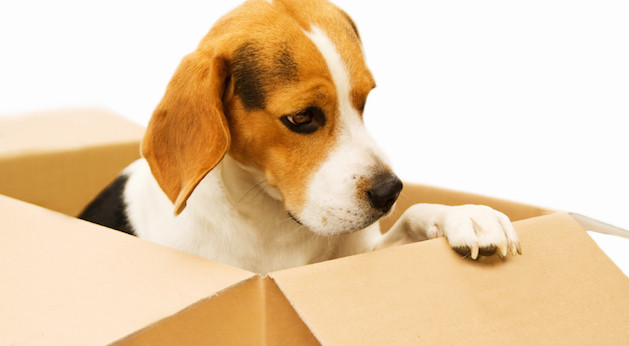
Utilities switched, moving truck reserved, new domicile secured, boxes packed – as you work through your moving checklist, are you forgetting something? Have you taken steps to make the move as easy as possible for the only family member who has no say about your relocation: the family pet?
While pets add an element to any move, it doesn’t have to be a stressful one, for you or your pet. Penske Truck Rental offers some pet-friendly moving tips to make the transition go as smoothly as possible for everyone in the family, including the four-legged members.
ID your animals
A door gets left open during the actual move, a pet escapes from a carrier or hotel room during a stopover – moving can be chaotic, and even the most well-behaved, homebody pet can get lost and confused during a move. Take steps to help increase the chance that a lost pet can be returned to you. Microchip your cat or dog before you move. One Ohio State University study found that lost pets with microchips are more likely to be reunited with their families than pets who aren’t chipped.
While animal shelters and veterinarians are most often equipped to detect and read microchips, the average Good Samaritan is not. So be sure to also have your pet wear a collar with an ID tag that includes his or her name and your mobile phone number. If the worst does happen and your pet gets lost during your move, notify animal shelters and veterinarian offices in your former hometown and in the area where your pet got lost.
Prepare for health needs
If your pet is on medication, don’t pack it away until you are ready to get in the car for the move. Likewise, keep his or her food for the last minute and keep enough of it with you so you don’t have to feed your pet an unfamiliar diet during the move. Strange food can upset his tummy during an already stressful time. Additionally, keep at least an extra week’s supply of food and medications in your travel kit, in case your belongings get delayed in transit.
Get your pet a checkup before moving day so you’ll be aware of any changes in health that could affect his or her ability to travel easily. Make a list of emergency veterinarians in towns along your travel route and at your destination, in case an emergency occurs.
While you’re packing and loading
Dogs and cats may both be tempted to chew on boxes and packing material, and they could choke on materials or get sick if they swallow something they shouldn’t. While you’re filling boxes, try to keep pets away from your packing area. If you’re packing in stages over several days, be sure to clean up and store any packing material from day to day so pets don’t have access to it.
To minimize the risk of a pet getting hurt, underfoot or lost while you’re packing, confine him to a small room such as a bathroom or closet while your furniture and boxes are being packed on the truck. Leave him with water and some food. Post a note on the door of the room alerting movers that a pet is confined there so they don’t open the door.
On the road
Before moving day, take your pet for short rides – especially if you have a pet that’s not used to being in the car. You may discover that your cat suffers from motion sickness, or that your dog prefers the security of riding in a crate rather than just a travel harness. Knowing how your pet reacts to travel can help you and your vet plan a course of action for minimizing travel stress, such as sedation or more frequent breaks in the trip.
The day of your move, transport your pet in your own car or in the cab of the rented moving truck you’ll be driving. Never put a pet in the back of any moving truck where they could get hurt, become sick or be exposed to uncomfortable temperatures. Keep plenty of food and water available, and consider starting your pet’s ride with an empty stomach so he or she will be less likely to experience an upset tummy on the drive.
Take rest stops every two hours and keep your pet leashed or in a crate when you stop. Never leave your pet unattended in your vehicle, especially in summer when temperatures inside a car or truck can get dangerously hot very quickly.
When you arrive at your new home, put your pet in a small room while you unload the truck. Once everything is in place, you can let him out to explore. Your new home will look and feel different to your dog or cat, but the familiar scent of your belongings will help him adjust quickly. For more moving advice and to find a rental truck, visitwww.pensketruckrental.com.



